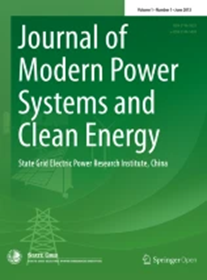基于图注意网络的深度强化学习拓扑可变电力系统电压/无功控制
IF 6.1
1区 工程技术
Q1 ENGINEERING, ELECTRICAL & ELECTRONIC
Journal of Modern Power Systems and Clean Energy
Pub Date : 2024-10-04
DOI:10.35833/MPCE.2023.000712
引用次数: 0
摘要
可再生能源的高比例并网和电网拓扑结构的动态变化要求加强电压/无功控制(VVC),以更快地管理电压波动。传统的基于模型的控制算法由于模型依赖性高,在线计算速度慢,越来越不能适应VVC的控制。为了解决这些问题,本文引入了一种基于图注意网络(GAT)的深度强化学习方法,用于拓扑可变电力系统的VVC。首先,结合实际电网的物理信息,提出了一种基于物理信息的GAT算法,并将其嵌入到近端策略优化算法中。GAT-PPO算法可以捕获节点特征之间的拓扑和空间相关性,以处理拓扑变化。为了解决训练缓慢的问题,ReliefF -S算法识别关键状态变量,显著降低状态空间的维数。然后,设计保留在经验缓冲区中的训练样本来缓解稀疏奖励问题。最后,在改进的IEEE 39总线系统和实际电网上进行了验证,与现有算法(包括PPO算法和双延迟深度确定性策略梯度(TD3)算法)相比,所提出的算法具有优越的性能。即使在涉及网格拓扑变化和增加可再生能源整合的场景下,该算法在训练过程中也表现出增强的收敛性,更快的求解速度和改进的VVC性能。同时,在采用的案例中,网络损耗分别降低了6.9%、10.80%和7.70%,显示出良好的经济效益。本文章由计算机程序翻译,如有差异,请以英文原文为准。
Graph Attention Network Based Deep Reinforcement Learning for Voltage/var Control of Topologically Variable Power System
The high proportion of renewable energy integration and the dynamic changes in grid topology necessitate the enhancement of voltage/var control (VVC) to manage voltage fluctuations more rapidly. Traditional model-based control algorithms are becoming increasingly incompetent for VVC due to their high model dependence and slow online computation speed. To alleviate these issues, this paper introduces a graph attention network (GAT) based deep reinforcement learning for VVC of topologically variable power system. Firstly, combining the physical information of the actual power grid, a physics-informed GAT is proposed and embedded into the proximal policy optimization (PPO) algorithm. The GAT-PPO algorithm can capture topological and spatial correlations among the node features to tackle topology changes. To address the slow training, the ReliefF -S algorithm identifies critical state variables, significantly reducing the dimensionality of state space. Then, the training samples retained in the experience buffer are designed to mitigate the sparse reward issue. Finally, the validation on the modified IEEE 39-bus system and an actual power grid demonstrates superior performance of the proposed algorithm compared with state-of-the-art algorithms, including PPO algorithm and twin delayed deep deterministic policy gradient (TD3) algorithm. The proposed algorithm exhibits enhanced convergence during training, faster solution speed, and improved VVC performance, even in scenarios involving grid topology changes and increased renewable energy integration. Meanwhile, in the adopted cases, the network loss is reduced by 6.9%, 10.80%, and 7.70%, respectively, demonstrating favorable economic outcomes.
求助全文
通过发布文献求助,成功后即可免费获取论文全文。
去求助
来源期刊

Journal of Modern Power Systems and Clean Energy
ENGINEERING, ELECTRICAL & ELECTRONIC-
CiteScore
12.30
自引率
14.30%
发文量
97
审稿时长
13 weeks
期刊介绍:
Journal of Modern Power Systems and Clean Energy (MPCE), commencing from June, 2013, is a newly established, peer-reviewed and quarterly published journal in English. It is the first international power engineering journal originated in mainland China. MPCE publishes original papers, short letters and review articles in the field of modern power systems with focus on smart grid technology and renewable energy integration, etc.
 求助内容:
求助内容: 应助结果提醒方式:
应助结果提醒方式:


